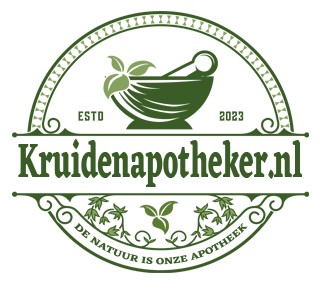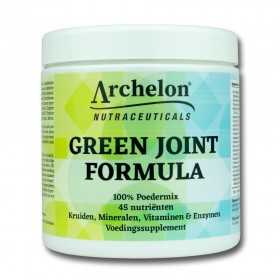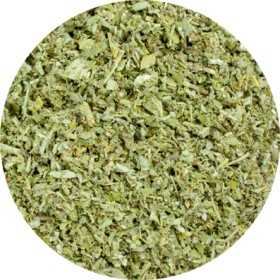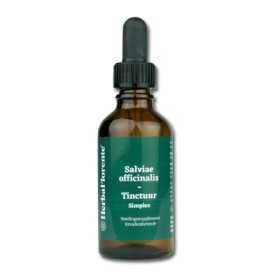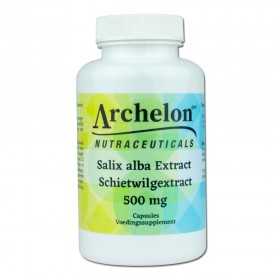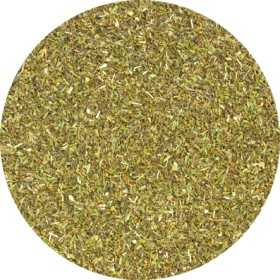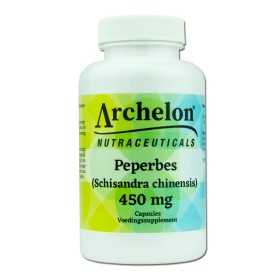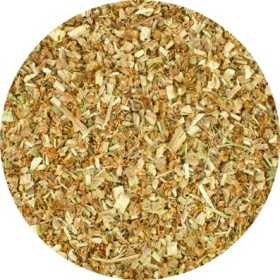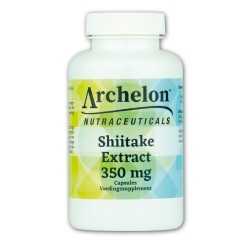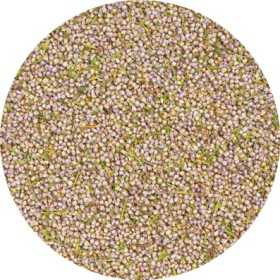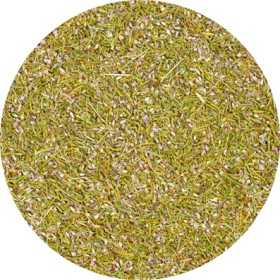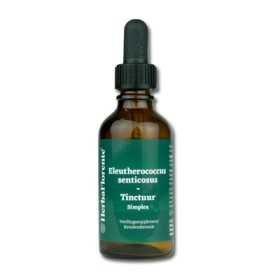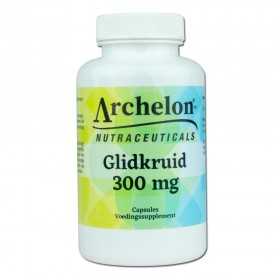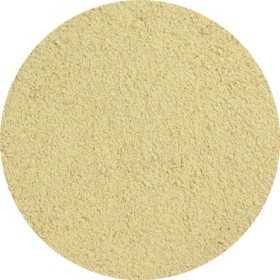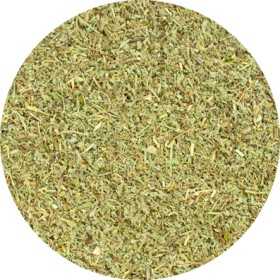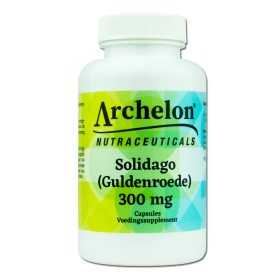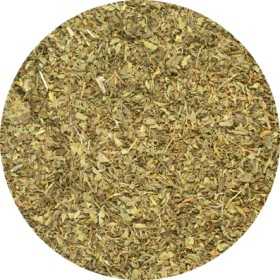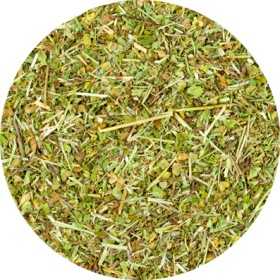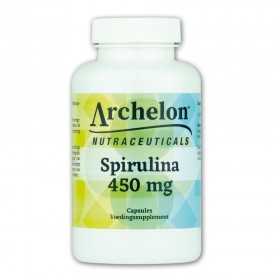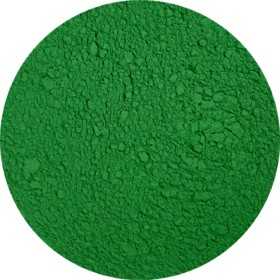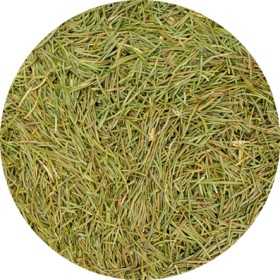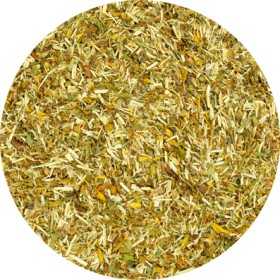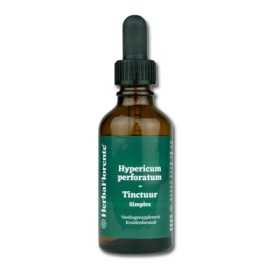Home
There are 410 products.
Rutin - 450 mg
Rutin, also known as a flavonoid or bioflavonoid, is a naturally occurring substance in vegetables, fruits, herbs and plants. It is known for its vibrant pigmentation and can have different colors. Rutin plays several important roles in plants, such as regulating growth, protecting against UV radiation, oxidation and heat, and maintaining plant metabolism.
Citrus fruits are particularly rich in rutin, but other foods also contain this substance, such as grapes, the peels of apples, pears, apricots, raspberries, onions, asparagus, tobacco plants, tea, rhubarb, blueberries and elderberries. Rutin also acts as an antioxidant, meaning it protects our cells and tissues from oxidative damage caused by free radicals.
Citrus fruits are particularly rich in rutin, but other foods also contain this substance, such as grapes, the peels of apples, pears, apricots, raspberries, onions, asparagus, tobacco plants, tea, rhubarb, blueberries and elderberries. Rutin also acts as an antioxidant, meaning it protects our cells and tissues from oxidative damage caused by free radicals.
€29.95
Sage - Salviae officinalis - Cut
True sage (Salvia officinalis L.) is a well-known herb that is used for various purposes. It has been used for centuries from China to ancient Rome. All kinds of magical properties were attributed to the little purple flower.
Sage is an antioxidant and can be used for menopausal symptoms. In addition, it supports normal menstruation. Sage is a natural soother for the throat, it supports the immune system and contributes to normal digestion.
Sage is an antioxidant and can be used for menopausal symptoms. In addition, it supports normal menstruation. Sage is a natural soother for the throat, it supports the immune system and contributes to normal digestion.
€2.00
From: €2.00
Sage Tincture - Salviae officinalis Tincture
Single herbal tincture made with dried herb of Salviae officinalis (Sage).
True sage (Salvia officinalis L.) is a well-known herb that is used for various purposes. It has been used for centuries from China to ancient Rome. All kinds of magical properties were attributed to the little purple flower.
Sage is an antioxidant and can be used for menopausal symptoms. In addition, it supports normal menstruation. Sage is a natural soother for the throat, it supports the immune system and contributes to normal digestion.
True sage (Salvia officinalis L.) is a well-known herb that is used for various purposes. It has been used for centuries from China to ancient Rome. All kinds of magical properties were attributed to the little purple flower.
Sage is an antioxidant and can be used for menopausal symptoms. In addition, it supports normal menstruation. Sage is a natural soother for the throat, it supports the immune system and contributes to normal digestion.
€11.95
Salix alba Extract - Willow Extract (Salicin) - 500 mg
Willow extract, derived from the bark of the white willow (Salix alba L.), naturally contains the valuable bioactive substance salicin. This extract is known for its supportive effect on supple muscles and joints.
The white willow (Salix alba L.), a common tree in the Netherlands, was examined in 1828 by the German pharmacist Johann Andreas Buchner. He discovered that the bark of the willow is rich in salicin, a special glycoside: a compound of a sugar with a non-sugar part, which only occurs in plants. Salicin supports joint function and contributes to the maintenance of supple muscles.
The white willow (Salix alba L.), a common tree in the Netherlands, was examined in 1828 by the German pharmacist Johann Andreas Buchner. He discovered that the bark of the willow is rich in salicin, a special glycoside: a compound of a sugar with a non-sugar part, which only occurs in plants. Salicin supports joint function and contributes to the maintenance of supple muscles.
€26.95
Savory Wort - Satureja hortensis
Savory (Satureja) belongs to the lip flower family (Lamiaceae or Labiatae). The scientific name of savory is derived from 'satyr'. During Roman times, savory was mainly used by the followers of Bacchus. They wore it in wreaths in their hair and used it regularly to increase their potency. Although many herbal books do not mention this, savory is one of the oldest remedies for increasing potency.
In ancient times, the Romans were fond of savory sauce, which was made with vinegar and served with fish and meat dishes in the same way as mint sauce. Most cooks had their own recipes for using savory. They used it in stuffings for veal, in sauces for fish and other dishes, and even in sausages and pork pies.
In ancient times, the Romans were fond of savory sauce, which was made with vinegar and served with fish and meat dishes in the same way as mint sauce. Most cooks had their own recipes for using savory. They used it in stuffings for veal, in sauces for fish and other dishes, and even in sausages and pork pies.
€2.00
From: €2.00
Schisandra chinensis - 450 mg
Schisandra, also known as the Schisandra berry (Schisandra chinensis), is known as one of the most important herbs in traditional Chinese medicine for promoting energy and vitality, and reducing stress. This dark red berry is rich in antioxidants, strengthens the immune system and promotes overall vitality. In addition, it provides protection and support to the liver and respiratory tract.
Schisandra has been used in traditional Chinese herbal medicine for over 2000 years. Only the berry with its seeds are used, harvested after the first frost and then dried in the sun. Schisandra is known as one of the most important herbs for promoting vitality.
Schisandra has been used in traditional Chinese herbal medicine for over 2000 years. Only the berry with its seeds are used, harvested after the first frost and then dried in the sun. Schisandra is known as one of the most important herbs for promoting vitality.
€28.95
Sheep's sorrel - Rumex acetosa
Sheep's sorrel (Rumex acetosa) is a perennial plant that is part of the knotweed family (Polygonaceae). This versatile plant grows to a height of 10 to 60 cm and spreads via numerous long, underground runners.
The leaves, which reach a length of 3 to 7 cm, have a characteristic spike shape and vary from obovate to narrow linear. From May until deep into autumn, sheep's sorrel adorns itself with plumes that usually have a greenish hue, sometimes with a light red glow. In certain specimens, the plumes can even turn dark red, which provides a striking contrast in the landscape.
The leaves, which reach a length of 3 to 7 cm, have a characteristic spike shape and vary from obovate to narrow linear. From May until deep into autumn, sheep's sorrel adorns itself with plumes that usually have a greenish hue, sometimes with a light red glow. In certain specimens, the plumes can even turn dark red, which provides a striking contrast in the landscape.
€2.25
From: €2.25
Shepherds Purse - Capsella Bursa postoris
The shepherd's purse (Capsella bursa-pastoris) belongs to the cruciferous family (Brassicaceae).
It is an upright plant that can grow between 5 and 60 cm high, and is annual or biennial in nature. Shepherd's purse is winter hardy and usually has a lignified taproot. The sinuously toothed leaves form a rosette around the spindle-shaped root.
The plant is processed into various commercial products. In folk medicine, infusions are used against bleeding and inflammation of the urinary tract, and as a compress on open bleeding wounds. In addition, young rosette leaves can be used in salads or braised in soups.
It is an upright plant that can grow between 5 and 60 cm high, and is annual or biennial in nature. Shepherd's purse is winter hardy and usually has a lignified taproot. The sinuously toothed leaves form a rosette around the spindle-shaped root.
The plant is processed into various commercial products. In folk medicine, infusions are used against bleeding and inflammation of the urinary tract, and as a compress on open bleeding wounds. In addition, young rosette leaves can be used in salads or braised in soups.
€2.00
From: €2.00
Shiitake Extract - 350 mg
Shiitake (Lentinula edodes) has its origins in the Far East and plays an important role in traditional Chinese medicine. This mushroom is extremely versatile thanks to its rich range of nutrients. It is, among other things, a good source of B vitamins, vitamin C, potassium, magnesium, phosphorus, fiber and proteins. Compared to mushrooms, shiitake contains 15 times more vitamin B6, 4 times more potassium and 10 times more magnesium. The phosphorus content is even twice as high.
Shiitake (Lentinula edodes) is a fast-growing, fleshy mushroom with a cap that varies from golden to dark brown. In Asian countries and Russia, mushrooms have been prized as popular dietary supplements for centuries, with shiitake being one of the favorites.
Shiitake (Lentinula edodes) is a fast-growing, fleshy mushroom with a cap that varies from golden to dark brown. In Asian countries and Russia, mushrooms have been prized as popular dietary supplements for centuries, with shiitake being one of the favorites.
€34.95
Shrub Heather (Flower) - Erica vulgaris
The Heather (Erica vulgaris - Calluna vulgaris) belongs to the heath family (Ericaceae) and grows throughout Europe, especially in Central and Northern Europe. It even reaches Western Siberia in the east. In the nineteenth century, Scottish immigrants brought the heather to Canada, from where it spread throughout North America. It is the only species in the genus Calluna, meaning it is a monotypic genus.
The shrub heath can grow to a height of 10-100 cm, sometimes even up to 150 cm in certain places. It has hermaphroditic, symmetrical flowers, with the calyx and petals being the same color. Purple flowers appear towards the end of the branches, creating the purple heaths from late July to early September.
The shrub heath can grow to a height of 10-100 cm, sometimes even up to 150 cm in certain places. It has hermaphroditic, symmetrical flowers, with the calyx and petals being the same color. Purple flowers appear towards the end of the branches, creating the purple heaths from late July to early September.
€2.80
From: €2.80
Shrub Heather - Erica vulgaris
The Heather (Erica vulgaris - Calluna vulgaris) belongs to the heath family (Ericaceae) and grows throughout Europe, especially in Central and Northern Europe. It even reaches Western Siberia in the east. In the nineteenth century, Scottish immigrants brought the heather to Canada, from where it spread throughout North America. It is the only species in the genus Calluna, meaning it is a monotypic genus.
The shrub heath can grow to a height of 10-100 cm, sometimes even up to 150 cm in certain places. It has hermaphroditic, symmetrical flowers, with the calyx and petals being the same color. Purple flowers appear towards the end of the branches, creating the purple heaths from late July to early September.
The shrub heath can grow to a height of 10-100 cm, sometimes even up to 150 cm in certain places. It has hermaphroditic, symmetrical flowers, with the calyx and petals being the same color. Purple flowers appear towards the end of the branches, creating the purple heaths from late July to early September.
€2.20
From: €2.20
Siberian Ginseng Tincture - Eleutherococcus senticosus Tincture
Single herbal tincture made with dried root of Eleutherococcus senticosus (Siberian ginseng).
Siberian ginseng (Eleutherococcus senticosus) has had a good reputation in both China and Russia for centuries as a supporter of the immune system. Siberian ginseng root extract is beneficial for memory and concentration.
The carrots are a rich source of beta-carotene, vitamins B1, B2, C and E, and they are high in eleutherosides. It is important not to confuse Siberian ginseng with its Korean variant (Panax ginseng) or the American one (Panax quinquefolius). Not only do the names differ, but also the properties.
Siberian ginseng (Eleutherococcus senticosus) has had a good reputation in both China and Russia for centuries as a supporter of the immune system. Siberian ginseng root extract is beneficial for memory and concentration.
The carrots are a rich source of beta-carotene, vitamins B1, B2, C and E, and they are high in eleutherosides. It is important not to confuse Siberian ginseng with its Korean variant (Panax ginseng) or the American one (Panax quinquefolius). Not only do the names differ, but also the properties.
€9.95
Skullcap - 300 mg
Skullcap (Scutellaria) is a versatile genus of both annual and perennial plants, belonging to the Lamiaceae family. The genus includes about two hundred species, all of which are characterized by their characteristic, calyx-shaped flowers. These flowers are distinguished by clearly visible upper and lower lips. The name "Scutellaria" is derived from the Latin word "scutella", which means "small shield" or "saucer", and refers to the shape of the calyx.
€21.95
Sleep Tight Herbal Tea
Herbal tea composed of various herbs
Nice before going to sleep
Nice before going to sleep
€3.95
Slippery Elm - Ulmi pubescent - Ulmus rubra
The Slippery elm (Ulmus rubra), also known as slippery elm, was initially mistaken for the Ulmus americana in 1753. It was not until 1793 that researchers discovered that it was a different species and gave it the name Ulmus rubra. This deciduous tree is mainly found in the humid highlands east of North America.
The slippery elm has traditionally had many uses in America. The tree grows quickly and produces durable wood that does not rot quickly. The strong fibers are often used to make thread or rope and are even suitable for clothing production.
The inner bark of the slippery elm is slimy and is often used to make tea. The dried and ground leaves are also used as tea.
The slippery elm has traditionally had many uses in America. The tree grows quickly and produces durable wood that does not rot quickly. The strong fibers are often used to make thread or rope and are even suitable for clothing production.
The inner bark of the slippery elm is slimy and is often used to make tea. The dried and ground leaves are also used as tea.
€9.30
From: €9.30
Smooth rupturewort - Herniaria glabra
Smooth rupturewort (Herniaria glabra) is a rare plant from the carnation family (Caryophyllaceae), which occurs as an annual, biennial or perennial herbaceous plant. It blooms from June to October.
Originally, the plant was used to treat hernias. It was also used against dropsy and to stimulate the kidneys.
Originally, the plant was used to treat hernias. It was also used against dropsy and to stimulate the kidneys.
€2.00
From: €2.00
Solidago (Goldenrod) - 300 mg
Solidago virgaurea, also known as Goldenrod or Goldenrod, is a native plant that traditionally grows in Europe and Asia. In earlier times, this golden yellow flower was a permanent part of the Dutch herb garden. The yellow flowers were traditionally dried on a large scale and ground into a base for paint.
Solidago supports the kidneys and their function. It can be used for discomfort prior to menstruation and menopausal symptoms. In addition, solidago helps keep the joints flexible, strengthens resistance and contributes to good mental balance.
Solidago supports the kidneys and their function. It can be used for discomfort prior to menstruation and menopausal symptoms. In addition, solidago helps keep the joints flexible, strengthens resistance and contributes to good mental balance.
€19.95
Spearmint - Mentha spicata
Spearmint, also known as green mint (Mentha spicata), is an aromatic perennial plant from the Lamiaceae family. This plant originally comes from Central and Southern Europe, where it regularly establishes itself as a feral plant. Peppermint (Mentha ×piperata), a commonly used variety in food and care products, originated from a cross between spearmint and water mint (Mentha aquatica).
The leaves of spearmint contain a wealth of essential oils, with carvone being the most important. This component is also found in caraway, which gives the mint its characteristic scent. However, the leaves contain little menthol, which makes the taste milder than that of peppermint.
The leaves of spearmint contain a wealth of essential oils, with carvone being the most important. This component is also found in caraway, which gives the mint its characteristic scent. However, the leaves contain little menthol, which makes the taste milder than that of peppermint.
€2.00
From: €2.00
Speedwell - Veronica officinalis
Speedwell (Veronica officinalis) is a perennial plant that forms a dense sward and belongs to the plantain family (Plantaginaceae). This plant occurs naturally in Eurasia.
The plant reaches a height of 10-50 cm and has stems that spread horizontally and then grow upwards. The stems are evenly hairy. The leaves, short-stalked, are elliptical or obovate in shape, with slightly toothed or serrate edges.
Male speedwell blooms from May to August with light blue flowers, which are darkly veined and have a size of 6-8 mm. There are also variants of the plant with dark blue, pink or white flowers. The flowers grow in bunches.
The plant reaches a height of 10-50 cm and has stems that spread horizontally and then grow upwards. The stems are evenly hairy. The leaves, short-stalked, are elliptical or obovate in shape, with slightly toothed or serrate edges.
Male speedwell blooms from May to August with light blue flowers, which are darkly veined and have a size of 6-8 mm. There are also variants of the plant with dark blue, pink or white flowers. The flowers grow in bunches.
€3.80
From: €3.80
Spirulina - 450 mg
Spirulina, a type of algae, provides support to the immune system through its rich nutrients and relieves fatigue.
The blue-green spirulina is a type of algae that contains both chlorophyll (green pigment) and phycocyanin (blue pigment). These single-celled algae form spiral microscopic strands and thrive in warm, fresh water.
With its abundance of essential nutrients, spirulina is invaluable to our body. It contains more than 60% complete protein, almost three times more than beef, and is rich in vitamin B complex, vitamin E, carotenoids, iron, manganese, zinc and essential fatty acids such as gamma-linolenic acid. With ten different mixed carotenoids, spirulina is the most beta-carotene-rich food known.
The blue-green spirulina is a type of algae that contains both chlorophyll (green pigment) and phycocyanin (blue pigment). These single-celled algae form spiral microscopic strands and thrive in warm, fresh water.
With its abundance of essential nutrients, spirulina is invaluable to our body. It contains more than 60% complete protein, almost three times more than beef, and is rich in vitamin B complex, vitamin E, carotenoids, iron, manganese, zinc and essential fatty acids such as gamma-linolenic acid. With ten different mixed carotenoids, spirulina is the most beta-carotene-rich food known.
€19.95
Spirulina - Spirulina platensis
Spirulina, a type of algae, provides support to the immune system through its rich nutrients and relieves fatigue.
The blue-green spirulina is a type of algae that contains both chlorophyll (green pigment) and phycocyanin (blue pigment). These single-celled algae form spiral microscopic strands and thrive in warm, fresh water.
With its abundance of essential nutrients, spirulina is invaluable to our body. It contains more than 60% complete protein, almost three times more than beef, and is rich in vitamin B complex, vitamin E, carotenoids, iron, manganese, zinc and essential fatty acids such as gamma-linolenic acid. With ten different mixed carotenoids, spirulina is the most beta-carotene-rich food known.
The blue-green spirulina is a type of algae that contains both chlorophyll (green pigment) and phycocyanin (blue pigment). These single-celled algae form spiral microscopic strands and thrive in warm, fresh water.
With its abundance of essential nutrients, spirulina is invaluable to our body. It contains more than 60% complete protein, almost three times more than beef, and is rich in vitamin B complex, vitamin E, carotenoids, iron, manganese, zinc and essential fatty acids such as gamma-linolenic acid. With ten different mixed carotenoids, spirulina is the most beta-carotene-rich food known.
€2.50
From: €2.50
Spruce - Picea Abies
The Norway spruce (Picea abies) belongs to the pine family (Pinaceae) and is native to Northern and Central Europe. It is an imposing conifer that can grow up to 50 meters high.
This tree is monoecious and has a narrow, cone-shaped crown. Spruce trees that grow at lower elevations tend to have wider crowns to be less affected by snow accumulation. The twigs are reddish to orange-brown, while the buds are smooth, brown and pointed. The needles are dark green on all sides and surround the twigs. They are stiff, sharply pointed, square in cross-section and can grow 1 to 2.5 cm long. The lifespan of the needles can be up to 5 to 7 years.
This tree is monoecious and has a narrow, cone-shaped crown. Spruce trees that grow at lower elevations tend to have wider crowns to be less affected by snow accumulation. The twigs are reddish to orange-brown, while the buds are smooth, brown and pointed. The needles are dark green on all sides and surround the twigs. They are stiff, sharply pointed, square in cross-section and can grow 1 to 2.5 cm long. The lifespan of the needles can be up to 5 to 7 years.
€2.00
From: €2.00
St John's Wort - Hyperici perforatum
St. John's Wort (Hypericum perforatum) has had a positive reputation in European herbal medicine for centuries. It can be used to support both moments of depression and cheerfulness, and it promotes a good night's sleep. In addition, St. John's wort is beneficial for bile function and contributes to healthy digestion, thanks to the presence of bioflavonoids, tannins and essential oils.
The use of St. John's wort dates back to the times of the Ancient Greeks and is traditionally harvested between June 21 and 24, on the occasion of the Feast of St. John, in both pagan and Christian traditions.
The use of St. John's wort dates back to the times of the Ancient Greeks and is traditionally harvested between June 21 and 24, on the occasion of the Feast of St. John, in both pagan and Christian traditions.
€2.00
From: €2.00
St. John's Wort Tincture - Hypericum perforatum Tincture
Single herbal tincture made with dried herb of Hypericum perforatum (St John's wort).
St. John's Wort (Hypericum perforatum) has had a positive reputation in European herbal medicine for centuries. It can be used to support both moments of depression and cheerfulness, and it promotes a good night's sleep. In addition, St. John's wort is beneficial for bile function and contributes to healthy digestion, thanks to the presence of bioflavonoids, tannins and essential oils.
The use of St. John's wort dates back to the times of the Ancient Greeks and is traditionally harvested between June 21 and 24, on the occasion of the Feast of St. John, in both pagan and Christian traditions.
St. John's Wort (Hypericum perforatum) has had a positive reputation in European herbal medicine for centuries. It can be used to support both moments of depression and cheerfulness, and it promotes a good night's sleep. In addition, St. John's wort is beneficial for bile function and contributes to healthy digestion, thanks to the presence of bioflavonoids, tannins and essential oils.
The use of St. John's wort dates back to the times of the Ancient Greeks and is traditionally harvested between June 21 and 24, on the occasion of the Feast of St. John, in both pagan and Christian traditions.
€10.95
